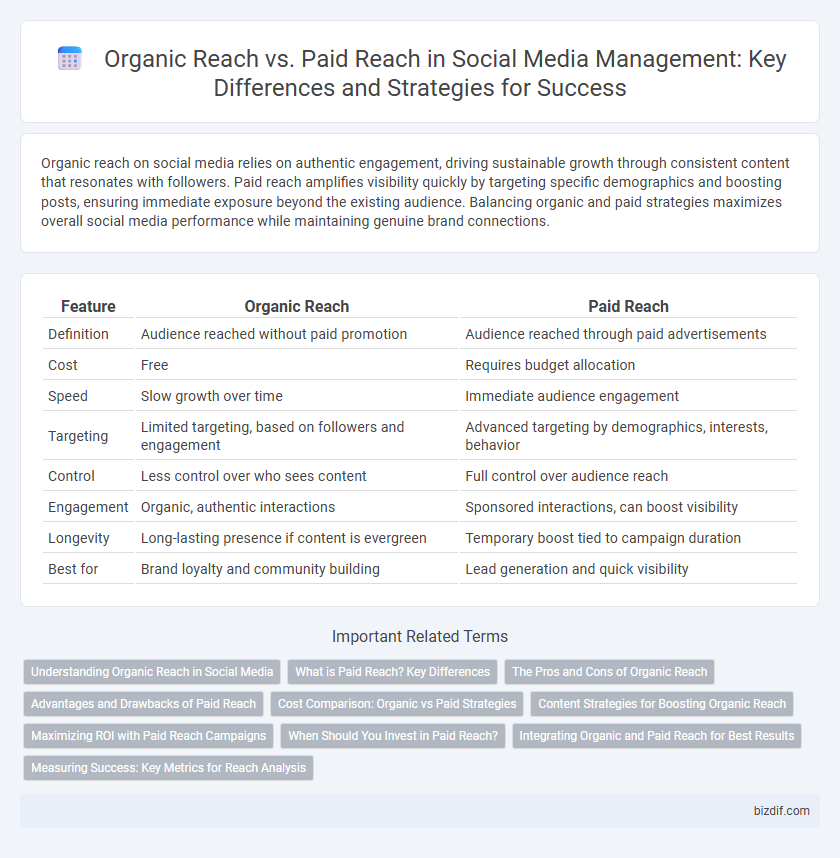Organic reach on social media relies on authentic engagement, driving sustainable growth through consistent content that resonates with followers. Paid reach amplifies visibility quickly by targeting specific demographics and boosting posts, ensuring immediate exposure beyond the existing audience. Balancing organic and paid strategies maximizes overall social media performance while maintaining genuine brand connections.
Table of Comparison
| Feature | Organic Reach | Paid Reach |
|---|---|---|
| Definition | Audience reached without paid promotion | Audience reached through paid advertisements |
| Cost | Free | Requires budget allocation |
| Speed | Slow growth over time | Immediate audience engagement |
| Targeting | Limited targeting, based on followers and engagement | Advanced targeting by demographics, interests, behavior |
| Control | Less control over who sees content | Full control over audience reach |
| Engagement | Organic, authentic interactions | Sponsored interactions, can boost visibility |
| Longevity | Long-lasting presence if content is evergreen | Temporary boost tied to campaign duration |
| Best for | Brand loyalty and community building | Lead generation and quick visibility |
Understanding Organic Reach in Social Media
Organic reach in social media refers to the number of unique users who see your content without paid promotion, driven by platform algorithms favoring authentic engagement. It emphasizes building genuine connections through consistent quality posts, audience interaction, and relevant hashtags to naturally expand visibility. Understanding organic reach helps marketers optimize content strategies for long-term growth without relying solely on advertising budgets.
What is Paid Reach? Key Differences
Paid reach refers to the number of people who see your social media content as a direct result of paid advertisements or promoted posts, allowing precise targeting based on demographics, interests, and behaviors. Unlike organic reach, which depends on natural engagement and the platform's algorithm, paid reach guarantees exposure to a specific audience, often resulting in faster and broader visibility. Key differences include cost involvement, control over audience selection, and the potential for measurable ROI through targeted ad campaigns.
The Pros and Cons of Organic Reach
Organic reach allows brands to build authentic relationships with their audience, fostering trust and long-term engagement without incurring direct costs. However, its limitations include slower growth and reduced visibility due to social media algorithms prioritizing paid content. Relying solely on organic reach can hinder rapid expansion and requires consistent, high-quality content to maintain audience interest.
Advantages and Drawbacks of Paid Reach
Paid reach on social media offers precise audience targeting and faster results compared to organic reach, enabling brands to effectively boost visibility and engagement. However, its drawbacks include higher costs and short-term impact, as once the campaign ends, the reach diminishes immediately. Balancing paid reach with organic strategies ensures sustained growth and audience loyalty while maximizing promotional effectiveness.
Cost Comparison: Organic vs Paid Strategies
Organic reach requires no direct financial investment, leveraging content quality and audience engagement to grow visibility over time. Paid reach demands a budget allocation for ads or boosted posts, offering immediate exposure but at a variable cost depending on targeting and competition. Businesses must evaluate cost-per-click (CPC) and cost-per-impression (CPM) metrics to determine the most efficient strategy for their social media goals.
Content Strategies for Boosting Organic Reach
Effective content strategies for boosting organic reach include creating high-quality, engaging posts that resonate with the target audience and encourage interactions such as likes, comments, and shares. Leveraging platform-specific features like Instagram Stories, Facebook Groups, or LinkedIn Articles increases visibility and fosters community engagement without paid promotion. Consistent posting schedules combined with audience analysis and optimization of content timing further enhance organic reach by aligning with users' active periods.
Maximizing ROI with Paid Reach Campaigns
Maximizing ROI with paid reach campaigns involves targeted audience segmentation and strategic ad placements that drive higher engagement compared to organic reach. Paid reach enables precise control over budget allocation and real-time performance analytics, optimizing conversions and minimizing ad spend waste. Leveraging detailed demographic and behavioral data ensures ads connect with high-intent users, significantly boosting return on investment.
When Should You Invest in Paid Reach?
Invest in paid reach when organic reach plateaus and audience engagement stagnates despite consistent content quality, as paid campaigns can precisely target demographics and amplify visibility. Allocate budget strategically during product launches, promotions, or time-sensitive events to maximize immediate impact and ROI. Use analytics to identify underperforming posts with high potential, boosting them to extend reach and convert new followers faster than organic efforts alone.
Integrating Organic and Paid Reach for Best Results
Integrating organic and paid reach in social media management amplifies audience engagement by leveraging the authenticity of organic content with the targeted precision of paid campaigns. Combining organic strategies like community building and content optimization with paid ads targeting specific demographics maximizes overall reach and conversion rates. This holistic approach ensures sustained brand visibility while efficiently allocating budget towards high-impact paid promotions.
Measuring Success: Key Metrics for Reach Analysis
Measuring success in social media management requires analyzing both organic reach and paid reach through key metrics such as engagement rate, click-through rate (CTR), and conversion rate. Organic reach reflects the natural visibility of content based on follower interaction and algorithm factors, while paid reach provides precise audience targeting and scalable exposure. Tracking these metrics helps optimize content strategies and budget allocation for maximizing overall reach and return on investment (ROI).
Organic reach vs Paid reach Infographic

 bizdif.com
bizdif.com